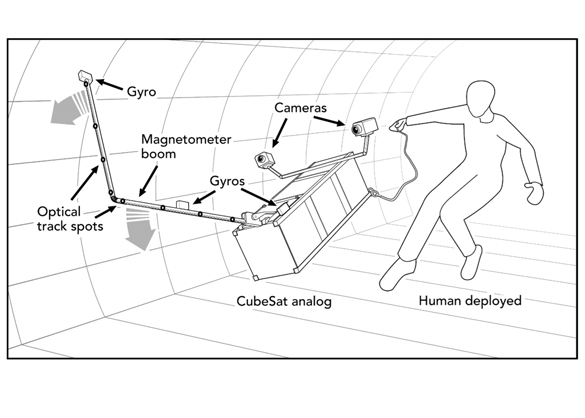CubeSat Articulated Boom Option Optimization in Microgravity (CABOOM)
PI: David Miles, Salam Rahmatalla (Co-I), University of Iowa - Iowa City
PI: David Miles, Salam Rahmatalla (Co-I), University of Iowa - Iowa City

- TA12 Materials, Structures, Mechanical Systems and Manufacturing
Magnetic field measurements are essential for near-Earth, interplanetary, and planetary missions and for the study and future forecasting of space weather. Recent instrumental advancements have focused on making smaller and low power instruments to enable constellation missions of many low-cost spacecraft. Magnetic field instruments are now small and light enough to be carried by CubeSats of ~10x10x30 cm. However, the magnetic field sensors need to be held away from the magnetic noise of the spacecraft on long deployable booms, and no robust and reliable solution currently exists for CubeSats.
Micro-g conditions will be provided by parabolic flights of a B727-200 aircraft operated by the Zero Gravity Corporation. The repeatability and reliability of the CubeSat magnetometer booms will be assessed using two experimental apparatus comprising the prototype booms, mass-equivalent CubeSat structures, and optical tracking and gyroscope instrumentation to capture the boom's motion.
The booms tested under this flight demonstration, when combined with an existing miniature fluxgate magnetometer, will enable robust and low-cost multipoint magnetic field measurements through CubeSat constellations. This directly addresses the 2015 NASA Technology Roadmap priority for "technologies that allow high-stability magnetic field measurements to be made in distributed systems" (TA 8.3.1.3).
Technology Details
-
Selection DateREDDI-F1-17B (Apr 2018)
-
Program StatusActive
- 3 Parabolic
Development Team
-
PIDavid Miles
-
PI Organization
-
Co-ISalam Rahmatalla
-
Co-I Organization
-
SponsorNASA

